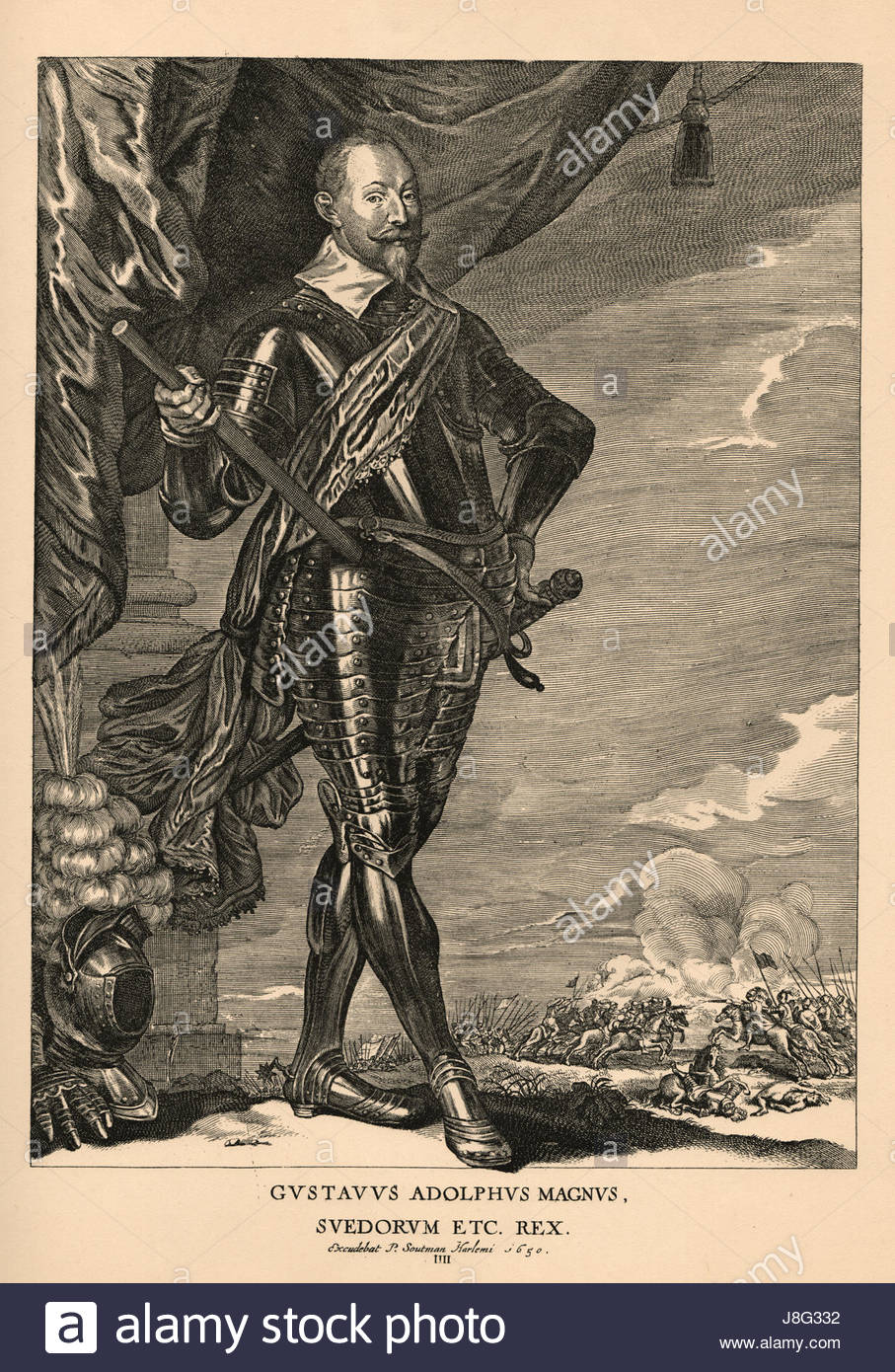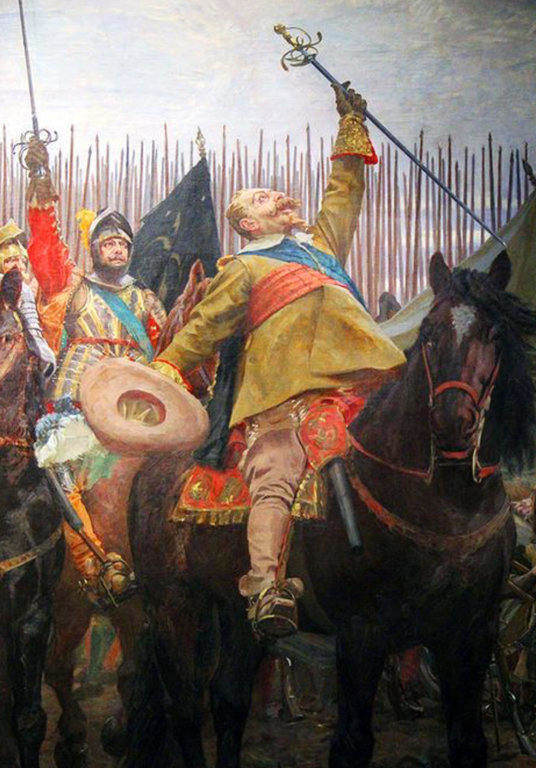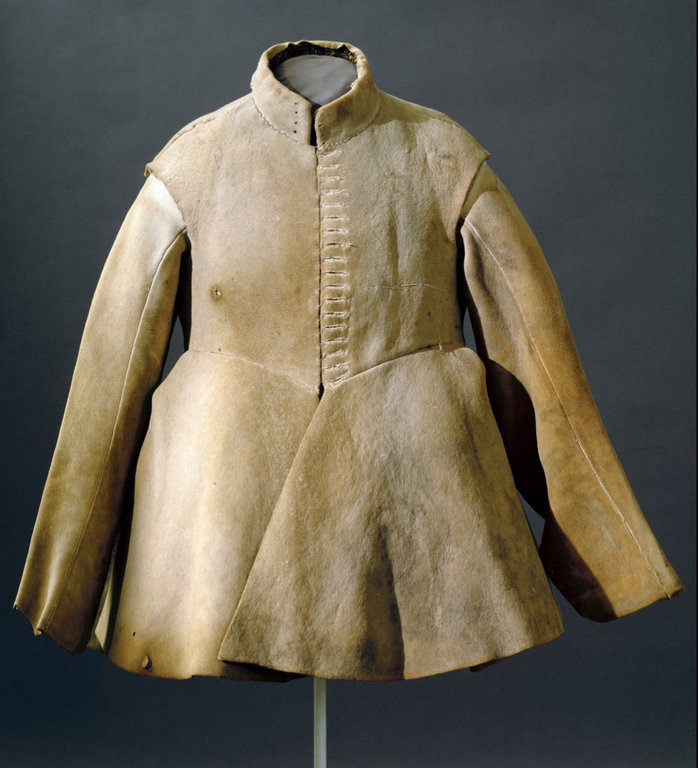| Author |
Message |
Pedro Paulo Gaião

|
 Posted: Sun 15 Dec, 2019 8:14 pm Post subject: Gustav Adolphus' Full Harness Posted: Sun 15 Dec, 2019 8:14 pm Post subject: Gustav Adolphus' Full Harness |
 |
|
So, a few years ago I came across a picture from a private collection, showing the Swedish landing at Pomerania, in the midst of the 30 Years War. What I found odd is that the armor has both closed greaves and sabatons:

I didn't take it very seriously until I found another private collection image showing similar helmet and full armor:

I have read in one of Osprey's books that painting of Gustavus were made coping one another, so we can see reminescent traces from the ones that were used as basis. I think the enclosed helmet might be the main (or perhaps the only) link between them.
My question is: these sources are reliable? I mean, if you take French Kings paintings or even any artistic evidence from the 17th century they were all 3/4 armor. I don't know when exactly magnates, officers and commanders started dropping leg armor, but I'm quite sure by that time they already have.
Henry VIII's tonlet armor and some other pieces from Greenwich Armoury had leg armor in 16th century, so, who knows ...
“Burn old wood, read old books, drink old wines, have old friends.”
Alfonso X, King of Castile (1221-84)
|
|
  |
 |
James Arlen Gillaspie
Industry Professional

Location: upstate NY Joined: 10 Nov 2005
Posts: 587
|
 Posted: Thu 19 Dec, 2019 9:08 am Post subject: Posted: Thu 19 Dec, 2019 9:08 am Post subject: |
 |
|
It was not unusual for late royal armours to come complete with greave/sabatons, such as this famous harness of Charles I, but the extent to which they were used for anything but royal portraits is uncertain. The greaves are exceptionally ugly because they were made to fit over boots.
 Attachment: 108.49 KB Attachment: 108.49 KB
[ Download ]
jamesarlen.com
|
|
   |
 |
Magnus K

Location: Stockholm Joined: 19 Dec 2016
Posts: 9
|
 Posted: Sun 22 Dec, 2019 9:30 am Post subject: Posted: Sun 22 Dec, 2019 9:30 am Post subject: |
 |
|
The pictures are probably for propaganda reasons to demonstrate power. The boats in the first picture look unrealistic like viking ships.
Gustavus Adolphus was unable to wear armour after being shot 1627 and the bullet still lodged in his shoulder. Instead he wore a buff leather coat which could deflect sword cuts. This may have led to his death at the Battle of Lützen in 1632.
|
|
  |
 |
Pedro Paulo Gaião

|
 Posted: Mon 23 Dec, 2019 10:21 am Post subject: Posted: Mon 23 Dec, 2019 10:21 am Post subject: |
 |
|
| Magnus K wrote: | The pictures are probably for propaganda reasons to demonstrate power. The boats in the first picture look unrealistic like viking ships.
Gustavus Adolphus was unable to wear armour after being shot 1627 and the bullet still lodged in his shoulder. Instead he wore a buff leather coat which could deflect sword cuts. This may have led to his death at the Battle of Lützen in 1632. |
It could be, but other pamphlets of the war shows Gustav unarmoured, like this one showing him piercing the Pope:
https://www.alamy.com/stock-photo-pamphlet-about-the-victory-of-the-swedish-king-gustavus-adolphus-over-59398649.html
Also, the first picture is showing the Landing at Pomerania, at that time he would still be able to wear armor.
| James Arlen Gillaspie wrote: | | It was not unusual for late royal armours to come complete with greave/sabatons, such as this famous harness of Charles I, but the extent to which they were used for anything but royal portraits is uncertain. The greaves are exceptionally ugly because they were made to fit over boots. |
Intersting, where this armor currently is? Do you know other royal full harnesses?
“Burn old wood, read old books, drink old wines, have old friends.”
Alfonso X, King of Castile (1221-84)
|
|
  |
 |
Magnus K

Location: Stockholm Joined: 19 Dec 2016
Posts: 9
|
 Posted: Mon 23 Dec, 2019 11:05 am Post subject: Posted: Mon 23 Dec, 2019 11:05 am Post subject: |
 |
|
These pictures may help in understanding.
 Attachment: 98.9 KB Attachment: 98.9 KB

 Attachment: 97.84 KB Attachment: 97.84 KB

 Attachment: 98.63 KB Attachment: 98.63 KB
[ Download ]
|
|
  |
 |
Bjorn Hagstrom

|
 Posted: Mon 23 Dec, 2019 11:10 am Post subject: Posted: Mon 23 Dec, 2019 11:10 am Post subject: |
 |
|
If there is any extant pieces of armour related to Gustav II Adolph, they would be held at the Swedish Royal Armoury
https://livrustkammaren.se/en
They are usually friendly and should be able to answer questions about their collection.
I know about armours form earlier regents kept there, and they have he actual items worn by him when he fell at Lützen (no arnour then, apart from a leather coat)
There is nothing quite as sad as a one man conga-line...
|
|
   |
 |
Pedro Paulo Gaião

|
 Posted: Mon 23 Dec, 2019 11:25 am Post subject: Posted: Mon 23 Dec, 2019 11:25 am Post subject: |
 |
|
| Bjorn Hagstrom wrote: | If there is any extant pieces of armour related to Gustav II Adolph, they would be held at the Swedish Royal Armoury
https://livrustkammaren.se/en
They are usually friendly and should be able to answer questions about their collection.
I know about armours form earlier regents kept there, and they have he actual items worn by him when he fell at Lützen (no arnour then, apart from a leather coat) |
Doesn't they have digitalized collection of their pieces, as the Met does? I tried to search for medieval armor in their catalog before but didn't have much luck
| Magnus K wrote: | | These pictures may help in understanding. |
I'm actually aware that the wore the leather coat at Lutzen (the pamphlet I showed seems to portray the same deer-skin coat), but I thought it's cutting protective capacities were basically speculative and not exactly intentional.
“Burn old wood, read old books, drink old wines, have old friends.”
Alfonso X, King of Castile (1221-84)
|
|
  |
 |
Magnus K

Location: Stockholm Joined: 19 Dec 2016
Posts: 9
|
 Posted: Mon 23 Dec, 2019 12:25 pm Post subject: Posted: Mon 23 Dec, 2019 12:25 pm Post subject: |
 |
|
It’s known that Gustavus Adolphus rarely wore armour. He is said to have put his trust in God. After sustaining several battle ”blemishes” he experienced physical discomfort from wearing armour. He also advocated new military tactics which emphasized mobility, where heavy armour was unhelpful. As firearms came to dominate the battle fields, armoured cavalry became increasingly obsolete.
The buff coat of Gustavus Adolphus is made from tough thick moose skin which is definitely able to deflect sword cuts by the rapiers commonly used at the time, and could even deflect bullets fired from a distance. It could obviously not deflect shots at point blank range nor rapier thrusts at 90 degree angles.
The Royal Armoury in Stockholm has battle armour used by Gustav Vasa and his sons, but I believe Gustavus Adolphus 17thC armour was mainly used for tournaments and pageantry.
|
|
  |
 |
James Arlen Gillaspie
Industry Professional

Location: upstate NY Joined: 10 Nov 2005
Posts: 587
|
|
   |
 |
Jean Henri Chandler

|
 Posted: Wed 25 Dec, 2019 7:55 pm Post subject: Posted: Wed 25 Dec, 2019 7:55 pm Post subject: |
 |
|
What was he wearing when he got killed? The buff coat?
| Quote: | | Towards 1:00 pm, in the thick mix of gun smoke and fog covering the field, the king was separated from his fellow riders and suffered multiple shots. A bullet crushed his left arm below the elbow. Almost simultaneously his horse suffered a shot to the neck that made it hard to control. In the mix of fog and smoke from the burning town of Lützen the king rode astray behind enemy lines. There he sustained yet another shot in the back, was stabbed and fell from his horse. Lying on the ground, he received a final, fatal shot to the temple. |
Sounds like tactics be damned, he would have benefited from a stout 3/4 harness and a helmet.
Books and games on Medieval Europe Codex Integrum
Codex Guide to the Medieval Baltic Now available in print
|
|
  |
 |
Daniel Staberg

|
 Posted: Thu 26 Dec, 2019 10:32 am Post subject: Posted: Thu 26 Dec, 2019 10:32 am Post subject: |
 |
|
| Jean Henri Chandler wrote: | What was he wearing when he got killed? The buff coat?
| Quote: | | Towards 1:00 pm, in the thick mix of gun smoke and fog covering the field, the king was separated from his fellow riders and suffered multiple shots. A bullet crushed his left arm below the elbow. Almost simultaneously his horse suffered a shot to the neck that made it hard to control. In the mix of fog and smoke from the burning town of Lützen the king rode astray behind enemy lines. There he sustained yet another shot in the back, was stabbed and fell from his horse. Lying on the ground, he received a final, fatal shot to the temple. |
Sounds like tactics be damned, he would have benefited from a stout 3/4 harness and a helmet. |
Nothing to do with tactics, Gustavus had a Polish musket ball lodged in his shoulder which made it intensly painfull to wear metal body armour as the ball put preassure on a nerve. Even without armour the impact on the nerve was bad enough, Gustavus lost the use of two fingers and the arm would act up from time to time as movement cause the musket ball to press harder on the nerve.
Also the description of his death which you quote leave out a key details while containing misleading parts, for example he was not behind enemy lines and rather than being alone he was escorted by a small retinue of retainers and noblemen. (In fact many of the details we know about Gustavus being wounded and his death come from the men with him including his page, August von Leublfing, who was mortally wounded when he tried to put the King on his own horse.
"There is nothing more hazardous than to venture a battle. One can lose it
by a thousand unforseen circumstances, even when one has thorougly taken all
precautions that the most perfect military skill allows for."
-Fieldmarshal Lennart Torstensson.
|
|
  |
 |
Jean Henri Chandler

|
 Posted: Fri 27 Dec, 2019 11:17 am Post subject: Posted: Fri 27 Dec, 2019 11:17 am Post subject: |
 |
|
Yeah that makes a lot more sense. I suppose it was a fitting punishment from the Poles considering how much suffering he caused them.
It also of course makes sense that he was not by himself behind enemy lines just separated from the main force along with his bodyguards. Do you know how many enemy troops attacked him? Would horse armor have still been in common use? I'm a little out of my depth when it comes to the 17th Century. A very apocalyptic time...
Books and games on Medieval Europe Codex Integrum
Codex Guide to the Medieval Baltic Now available in print
|
|
  |
 |
Magnus K

Location: Stockholm Joined: 19 Dec 2016
Posts: 9
|
 Posted: Sun 29 Dec, 2019 11:22 am Post subject: Posted: Sun 29 Dec, 2019 11:22 am Post subject: |
 |
|
| Jean Henri Chandler wrote: | Yeah that makes a lot more sense. I suppose it was a fitting punishment from the Poles considering how much suffering he caused them.
It also of course makes sense that he was not by himself behind enemy lines just separated from the main force along with his bodyguards. Do you know how many enemy troops attacked him? Would horse armor have still been in common use? I'm a little out of my depth when it comes to the 17th Century. A very apocalyptic time... |
The King and some body guards were separated from the main force in no-mans land and massive fog added to the confusion of battle at Lützen. The group twice ran into groups of Imperial cuirassiers with ensuing melee. After some desperate fighting the severely wounded king could no longer be kept in the saddle and he fell to the ground where he was given the coup de grace and his uniform taken as war booty by the Imperial cavalry and displayed in Vienna in triumph. Gustavus Adolphus’s buff coat which photo was posted above was returned to Sweden after WWI in gratitude for humanitarian efforts. It’s now on display at the Royal Armoury in Stockholm.
|
|
  |
 |
|
|

